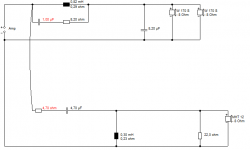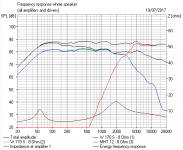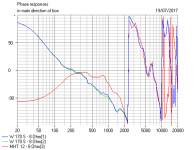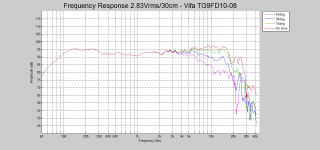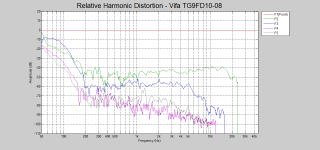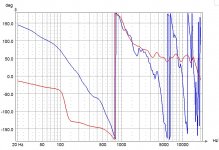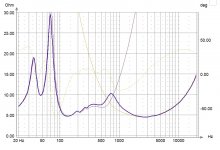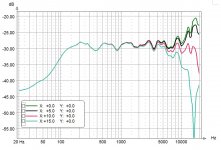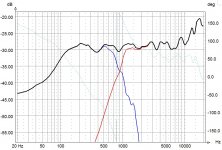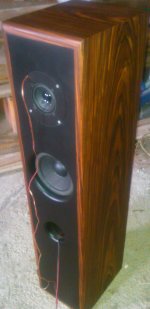Out of curiosity, could you guys elaborate on the detriments of a full range as compared to a traditional tweeter?
There is a wide range of quality among FRs… the things usually called into question are dispersion at higher frequencies, as well as uncontrolled breakup. On the latter, all FRs operate as a piston up to a certain point and then start “breaking up” in the rest of the range. In an ideal world the breakup is a controlled decrease of the radiating area (ie less of the cone radiates). How well this is achieved is a measure of how well a FR does the top end. They can certainly go up, the old FF85k was rated to 32kHz, the newer one, FF85wk (used in the FAST i pictured earlier) to 25 KHz but is more controlled.
And since we are all building speakers for our personal use one has to factor in high frequency hearing loss. If you are an old guy that hears up to 10kHz then that last octave might not be as important to you.
dave
...Vifa Peerless TC9/TG9 seem to work well in the tweeter role and can be crossed at 500Hz if you want to do that, and you can still use a pretty shallow slope. They lack a bit for sensitivity, coming in around 85-87dB/W
I would Veto use of the TC9. They sound lifeless with little to no capability to transmit low level information (ie low DDR).
The 4 i had measured an average of 84.4 dB with a 0.6 dB variance lowest to highest.
dave
The Ariels have quite good response off-axis. I've measured these poor speakers to death and see no issues with crossing the 5" midwoofers at 3.8KHz.
Is that an in-room measurement? I'd prefer to see gated, quasi-anechoic. That tell me what the speaker is doing without the room clouding the picture.
A small woofer like a 5" dia. unit can work well up to 2-3kHz. This is where directivity starts to crap out (narrow) for that size driver, so I am little surprised to see almost 4kHz working for you. Sorry I did not know the drivers in use in the Ariel, I only saw your on-axis measurement. What is the 5"er?
Too often I see people designing only with flat on axis response in mind and using too large a woofer with a 1" dome tweeter. That size woofer's off axis response would be falling off badly off axis by 2kHz, for instance.
There is also the other school of thought - use a very small midrange (e.g. Scan-Speak 10F), or a 3" dome midrange, that can be crossed over at 5k Hz or higher. There the ear starts is becoming less and less sensitive to the crossover region integration issues, etc. It's that 750Hz-5kHz band where the ear is very sensitive to various acoustic problems. Cross over below, or above, when possible.
I would Veto use of the TC9. They sound lifeless with little to no capability to transmit low level information (ie low DDR).
The 4 i had measured an average of 84.4 dB with a 0.6 dB variance lowest to highest.
dave
I use the TG9 myself. I know that the TC9 has received a lot of praise so I threw it in there as well.
I know that the TC9 has received a lot of praise so I threw it in there as well.
The reason i bought the ones i have.
dave
Sorry I did not know the drivers in use in the Ariel, I only saw your on-axis measurement. What is the 5"er?
Vifa P13WH-00, Scan Speak D2905.
dave
I'd suggest more prudence before tearing into an engineer working on a start of the art radio telescope, particularly a modest one who has published her electronic designs on the web.Yet another person who only looks at the on-axis response! Ignorance is bliss I guess.
Sorry, suzy, but you didn't deserve that spray.
I have no great theories about why tweeters or woofers are problematic, but they are. As Planet10 (Dave) says, the idea of a cone tweeter or small fullrange cone is the radiating area gets smaller as the frequency increases.
I think this Monacor HT-22-8 closed back cone tweeter is quite good. HT-22/8
At high frequency it must behave much like a metal tweeter.
But whatever I do, I seem to find an awful resonance in the phase plot. Even with a planar tweeter like the Visaton MHT-12.
It's most evident on the phase plot, and FWIW, group delay or stored energy is related to the rate of change of phase, and doubtless the more direct waterfall of stored energy.
Here's a 6 inch bass with its inevitable 6kHz cone/surround resonance. And 6kHz is about 3cm half-wavelength. But even the planar tweeter is getting a distinct kink in phase. That's breakup on the woofer AND the tweeter.
We need more rigid materials.
I think this Monacor HT-22-8 closed back cone tweeter is quite good. HT-22/8
At high frequency it must behave much like a metal tweeter.
But whatever I do, I seem to find an awful resonance in the phase plot. Even with a planar tweeter like the Visaton MHT-12.
It's most evident on the phase plot, and FWIW, group delay or stored energy is related to the rate of change of phase, and doubtless the more direct waterfall of stored energy.
Here's a 6 inch bass with its inevitable 6kHz cone/surround resonance. And 6kHz is about 3cm half-wavelength. But even the planar tweeter is getting a distinct kink in phase. That's breakup on the woofer AND the tweeter.
We need more rigid materials.
Attachments
Last edited:
Sorry Dave, this is not correct. I owned a pair in the early 80s. The basket was a stamped steel pincushion type measuring 130mm in it round part and more at the corners. Cone area was 92 cm square, bigger than a Satori 5" (70 cm sq) and almost as big as a Scan Speak 15W Revelator (95 cm sq). I still have the datasheets and they are still available on the net. Check it out.The B110 in the LS3/5A is a 4”.
dave
Out of curiosity, could you guys elaborate on the detriments of a full range as compared to a traditional tweeter?............
First there is directivity. Even slightly off axis for 3" makes the range over 8KHz drop in level quite rapidly. Lets look at Faital 3fe22, a 3" mid-hi or extended range driver.

If we look at 60deg angle, it has a deep null at 7KHz that is quite wide. It starts at 4KHz and goes up to 15KHz.
Now lets look at Morel CAT308:

Measured at exactly same conditions, (at 0, 30 and 60 deg angles), it holds up quite well up to 13KHz at 60deg. If we look at 30deg angles in these two, the difference is much more obvious - in extended range there is 20dB dip that starts at 7KHz and goes up to 15KHz, while the dome tweeter is pretty much the same as on axis up to 15KHz, but few dB lower in level.
Now, if we look at waterfall plot, we see that with 3" driver there are few very wide ridges that are pretty high in level to.

The dome tweeter is much better in that regard, as can be seen:

These things, along with the weight of moving system in extended range that is about 5-10 times higher than in good dome tweeter makes it much bigger compromise for high frequencies than dome tweeter. Small but high quality 3" extended range can not possibly play 3KHz, 4KHz or 5KHz (not to mention higher than that) as good and as detailed as high quality dome tweeter (especially if the tweeter is waveguide loaded).
In my experience, with 3" mid-hi drivers you lose the fine subtleties and details in instruments that play that high, and it makes the differences between instruments smaller.
That being said, i have recently made a FAST system (i believe that's the popular name for it) with Visaton FRS8 and he is quite pleased with them. So, it ends up on your preference.
I find it interesting that despite all the directivity arguments, some of the most highly regarded British speakers ever from companies like Spendor (BC1, D7), Harbeth and B&W, are based on 7 and 8 inch drivers crossing over at or above 3 KHz. The BBC LS3/5A which was famous for its incredible midrange was based on a 5.25" driver crossing over at 3 KHz. SB acoustics in their new 2.5 way kits, cross both the Satori MW16P and 17MFC driver at 3 KHz.
There are tons of myths that the Internet sheep keep repeating. If you believed everything you read on these forums you would never cross a 3/4" tweeter to an 8" woofer but the Snell K and JPW AP2/3 did It and those speakers still surprise people now with how good they sound. It would probably be best that I don't mention the box Q chosen for those designs because It could give some people a heart attack!
You are right: http://p10hifi.net/TLS/drivers/images/B110/B110_SP1003.gif
I sold a lot of them in the day… fading memory i guess.
dave
I sold a lot of them in the day… fading memory i guess.
dave
I most always find that small, paper coned wide range drivers to have a 'dry' sounding HF response and are need of a good dome tweeter to offset that tendency.
The TC9 is no exception to that conclusion, as good as it is for the price, it still needs that upper sparkle that a good dome might offer. Crossing over at 300 -500c/s and around 3Kc/s will give surprising results for the modest outlay for such a driver.
(I'm more of an OB advocate than for something being muzzled in a box.)
C.M
The TC9 is no exception to that conclusion, as good as it is for the price, it still needs that upper sparkle that a good dome might offer. Crossing over at 300 -500c/s and around 3Kc/s will give surprising results for the modest outlay for such a driver.
(I'm more of an OB advocate than for something being muzzled in a box.)
C.M
Last edited:
That being said, i have recently made a FAST system (i believe that's the popular name for it) FOR A FRIEND with Visaton FRS8 and he is quite pleased with them. So, it ends up on your preference.
Missed a few words there
First there is directivity. Even slightly off axis for 3" makes the range over 8KHz drop in level quite rapidly. Lets look at Faital 3fe22, a 3" mid-hi or extended range driver.
If we look at 60deg angle, it has a deep null at 7KHz that is quite wide. It starts at 4KHz and goes up to 15KHz.
Now lets look at Morel CAT308:
Measured at exactly same conditions, (at 0, 30 and 60 deg angles), it holds up quite well up to 13KHz at 60deg. If we look at 30deg angles in these two, the difference is much more obvious - in extended range there is 20dB dip that starts at 7KHz and goes up to 15KHz, while the dome tweeter is pretty much the same as on axis up to 15KHz, but few dB lower in level.
Now, if we look at waterfall plot, we see that with 3" driver there are few very wide ridges that are pretty high in level to.
The dome tweeter is much better in that regard, as can be seen:
These things, along with the weight of moving system in extended range that is about 5-10 times higher than in good dome tweeter makes it much bigger compromise for high frequencies than dome tweeter. Small but high quality 3" extended range can not possibly play 3KHz, 4KHz or 5KHz (not to mention higher than that) as good and as detailed as high quality dome tweeter (especially if the tweeter is waveguide loaded).
In my experience, with 3" mid-hi drivers you lose the fine subtleties and details in instruments that play that high, and it makes the differences between instruments smaller.
That being said, i have recently made a FAST system (i believe that's the popular name for it) with Visaton FRS8 and he is quite pleased with them. So, it ends up on your preference.
I deleted your giant pictures so that this post is condensed. The original pics are HERE.
IMO using these examples of drivers to make your argument is rather biased. That Faital Pro 3" is not indicative of every driver of that size. You only talk about dispersion and other high frequency issues and don't bother to touch on the fact that you cannot cross the Morel dome tweeter at, say, 500Hz (I would not even recommend 1kHz!). That's one of the main arguments FOR using a full ranger, the ability to cross low. Doing so solves several of the problems that occur right in the sensitive part of one's hearing range when you use a dome tweeter. If there are some weaknesses at 15kHz in a full ranger I am much less concerned - that is getting above the range of many people's hearing (I can't hear a pure tone above 15kHz, can you?).
I attached data on the 3.5" TG9 driver that I mentioned as a comparison. Not high sensitivity, but makes a fine tweeter that can be crossed as low as 300 Hz (with some input power limitations) or closer to 750Hz as a low-cross tweeter.
Attachments
Last edited:
I deleted your giant pictures so that this post is condensed. The original pics are HERE.
IMO using these examples of drivers to make your argument is rather biased. That Faital Pro 3" is not indicative of every driver of that size.
Faital is not indicative of every one 3" extended range regarding distortion or flatness of frequency response, but it is indicative regarding directivity, and comparable to the Morel tweeter because measurements were done with the same measurement equipment in the same conditions. We can't compare apples and oranges when looking at measurements of specific drivers when we try to compare their performance.
.......
You only talk about dispersion and other high frequency issues and don't bother to touch on the fact that you cannot cross the Morel dome tweeter at, say, 500Hz (I would not even recommend 1kHz!). That's one of the main arguments FOR using a full ranger, the ability to cross low. Doing so solves several of the problems that occur right in the sensitive part of one's hearing range when you use a dome tweeter. If there are some weaknesses at 15kHz in a full ranger I am much less concerned - that is getting above the range of many people's hearing (I can't hear a pure tone above 15kHz, can you?
I also talk about energy storage and how quickly the driver stops. That is why i mentioned mass of the moving system - the inertia of extended range moving system doesn't allow it to play as precise at high frequencies as dome tweeter (>3KHz) because it can be easily 5-10 times larger than moving mass of tweeter.
Vifa TG9 you mention has Mms = 2,8gr, while Morel (or any other quality tweeter) has about 0,40gr. Not to mention SS D2608/91300 that has Mms of only 0,18gr. It may not sound as much but that is 15 times larger mass than D2608/91300. It is certainly very easy to hear the difference when FAST is compared side by side to a loudspeaker that has dome tweeter.
You are right about not being able to cross Morel (or any other tweeter for that matter) as low as VifaTG9, but my point is that (imo) i don't need to. Using a tweeter in a waveguide enables me to cross it as low as 1500Hz, and i find that quite suitable.
Zvu - what crossover point / slope did you use there?
Here it is. I gave him the schematic with mods to cope with rising response of Visaton FRS8 but i told him to listen it first of axis for some time and see how it sounds in his room. If there is too much high frequency energy, he should do the mods. If room absorbs it, then he can listen it off axis and enjoy.
Attachments
Last edited:
Vifa TG9 you mention has Mms = 2,8gr, while Morel (or any other quality tweeter) has about 0,40gr..
You're forgetting SD..
It is certainly very easy to hear the difference when FAST is compared side by side to a loudspeaker that has dome tweeter..
There is many dome tweeters whith less details than good small fullrange..
I'm not sure that crossover point at 500Hz-1kHz, which is suitable for 2-3' fullrangers, is less problematic than 1k5-2k5..That's one of the main arguments FOR using a full ranger, the ability to cross low. Doing so solves several of the problems that occur right in the sensitive part of one's hearing range when you use a dome tweeter.
We are quite sensitive for both..
- Status
- This old topic is closed. If you want to reopen this topic, contact a moderator using the "Report Post" button.
- Home
- Loudspeakers
- Multi-Way
- Opinions: Tweeter Crossover - High vs Low?
